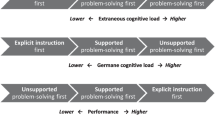Abstract
The purpose of this study was to investigate three instructional design variables hypothesized to improve rule learning by use of information processing methods. These variables included: analysis and structure of information, response-sensitive sequencing of information, and monitoring of learning time. Using secondary education students learning internal punctuation rules, results from two experiments showed that (a) structuring information by a schematic analysis improved learning over a taxonomic analysis, (b) a response-sensitive sequence that first adapted instruction for generalization and second discrimination improved learning over either sequence separately, and (c) program monitoring of the display time interval improved learning over learner control. Findings are discussed in reference to an interactive nature of learning theory, instructional systems, and computer technology.
Similar content being viewed by others
References
Bloom, B. S. (1974). Time and learning.American Psychologist, 29, 682–688.
Clark, R. E. (1983). Reconsidering research on learning from media.Review of Educational Research, 53, 445–459.
Clark, R. E. (1984). Research on student thought processes during computer-based instruction.Journal of Instructional Development, 7(3), 2–5.
Greeno, J. G. (1980). Some examples of cognitive task analysis with instructional implications. In R. E. Snow, P. A. Federico, and W. E. Montague (Eds.),Aptitude, learning, and instruction, Vol. 2: Cognitive process analyses of learning and problem solving. Hillsdale, NJ: Erlbaum.
Johansen, K. J., & Tennyson, R. D. (1983). Effect of adaptive advisement on perception in learner controlled, computer-based instruction using a rule-learning task.Educational Communication and Technology journal, 31, 226–236.
Mandler, J. M. (1979). Categorical and schematic organization in memory. In C. R. Puff (Ed.),Memory Organization and Structure, (pp. 98–127). New York, NY: Academic Press.
Miller, G. A., Galanter, E., and Pribram, K. H. (1960).Plans and the structure of behavior. New York: Holt, Rinehart & Winston.
Newell, A., Shaw, J., & Simon, H. (1960). Report on a general problem-solving program.Proceedings of the international conference on information processing. Paris: UNESCO.
Newell, A., & Simon, H. A. (1972).Human problem solving. Englewood Cliffs, NJ: Prentice-Hall.
Park, O. (1984). Example comparison strategy vs attribute identification strategy in concept learning.American Educational Research Journal, 21, 145–162.
Park, O., & Tennyson, R. D. (1980). Adaptive design strategies for selecting number and presentation order of example in coordinate concept acquisition.Journal of Educational Psychology, 72, 362–371.
Rothen, W., & Tennyson, R. D. (1978). Application of Bayes’ theory in designing computerbased adaptive instructional strategies.Educational Psychologist, 12, 317–323.
Tennyson, R. D. (1981). Use of adaptive information for advisement in learning concepts and rules using computer-assisted instruction.American Educational Research Journal, 4, 425–438.
Tennyson, R. D., &Cocchiarella, M. J. (in press). An empirically based instructional design theory for teaching concepts.Review of Education Research.
Tennyson, R. D., Christensen, D. L., & Park, S. (1984). The Minnesota adaptive instructional system: An intelligent CBI system.Journal of Computer-Based Instruction, 11, 2–13.
Tennyson, R. D., & Boutwell, R. C. (1974). Methodology for defining instance difficulty in concept teaching.Educational Technology, 14(9), 45–59.
Tennyson, R. D. & Park, O. (1984). Computerbased adaptive instructional systems: A review of empirically-based models.MachineMediated Learning, 1, 129–153.
Tennyson, R. D., Park, O., & Christensen, D. L. (1985). Adaptive control of learning time and content sequence in concept-learning using computer-based instruction.Journal of Educational Psychology, 77, 481–491.
Tennyson, R. D., & Park, S. I. (in press). Interactive effect of process learning time and ability level in concept learning using computer-based instruction.Journal of Structural Learning.
Tennyson, R. D., & Rothen, W. (1979). Management of computer-based instruction: Design of an adaptive control strategy.Journal of Computer-based Instruction, 5, 126–139.
Tennyson, R. D., Youngers, J., & Suebsonthi, P. (1983). Concept learning by children using instructional and presentation forms for prototype formation and classification-skill development.Journal of Educational Psychology, 75, 280–291.
Wagner, R. K. & Sternberg, R. J. (1984). Alternative conceptions of intelligence and their implications for education.Review of Educational Research, 54, 179–223.
Ward, T. B. (1983). Response tempo and separable-integral responding: Evidence for an integral-to-separable processing sequence in visual perception.Journal of Experimental Psychology: Human Perception and Performance, 9, 103–112.
Author information
Authors and Affiliations
Rights and permissions
About this article
Cite this article
Tennyson, R.D., Welsh, J.C., Christensen, D.L. et al. Interactive effect of information structure sequence of information and process learning time on rule learning using computer-based instruction. ECTJ 33, 213–223 (1985). https://doi.org/10.1007/BF02769162
Issue Date:
DOI: https://doi.org/10.1007/BF02769162




